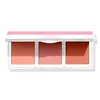What's inside
What's inside
 Key Ingredients
Key Ingredients

No key ingredients
 Concerns
Concerns

 Ingredients Side-by-side
Ingredients Side-by-side

Synthetic Fluorphlogopite
Polymethylsilsesquioxane
Mica
Cosmetic ColorantDipentaerythrityl Hexahydroxystearate
EmulsifyingLauryl Dimethicone
Skin ConditioningNeopentyl Glycol Dicaprylate/Dicaprate
EmollientZinc Stearate
Cosmetic ColorantCaprylyl Glycol
EmollientEthylhexylglycerin
Skin ConditioningCI 77163
Cosmetic ColorantCI 15850
Cosmetic ColorantCI 77742
Cosmetic ColorantTitanium Dioxide
Cosmetic ColorantIron Oxides
Ultramarines
CI 19140
Cosmetic ColorantCI 42090
Cosmetic ColorantSynthetic Fluorphlogopite, Polymethylsilsesquioxane, Mica, Dipentaerythrityl Hexahydroxystearate, Lauryl Dimethicone, Neopentyl Glycol Dicaprylate/Dicaprate, Zinc Stearate, Caprylyl Glycol, Ethylhexylglycerin, CI 77163, CI 15850, CI 77742, Titanium Dioxide, Iron Oxides, Ultramarines, CI 19140, CI 42090
Ingredients Explained
These ingredients are found in both products.
Ingredients higher up in an ingredient list are typically present in a larger amount.
Ci 15850 is the pigment color red. It is an azo dye and created synthetically.
Azo dyes need to be thoroughly purified before use. This allows them to be more stable and longer-lasting.
This ingredient is common in foundations, lipsticks, and blushes. This color is described as brown/orangey red.
It has many secondary names such as Red 6 and Red 7. According to a manufacturer, Red 6 usually contains aluminum.
Learn more about CI 15850CI 19140 is also known as Tartrazine. Tartrazine is a synthetic dye used in cosmetics, foods, and medicine to add a yellow color.
Tartrazine is created from petroleum and is water-soluble.
Some people may experience allergies from this dye, especially asthmatics and those with an aspirin intolerance.
Learn more about CI 19140This synthetic powder is used to add a pearly/white color in cosmetics.
Ethylhexylglycerin (we can't pronounce this either) is commonly used as a preservative and skin softener. It is derived from glyceryl.
You might see Ethylhexylglycerin often paired with other preservatives such as phenoxyethanol. Ethylhexylglycerin has been found to increase the effectiveness of these other preservatives.
Mica is a naturally occurring mineral used to add shimmer and color in cosmetics. It can also help improve the texture of a product or give it an opaque, white/silver color.
Serecite is the name for very fine but ragged grains of mica.
This ingredient is often coated with metal oxides like titanium dioxide. Trace amounts of heavy metals may be found in mica, but these metals are not harmful in our personal products.
Mica has been used since prehistoric times throughout the world. Ancient Egyptian, Indian, Greek, Roman, Aztec, and Chinese civilizations have used mica.
Learn more about Mica